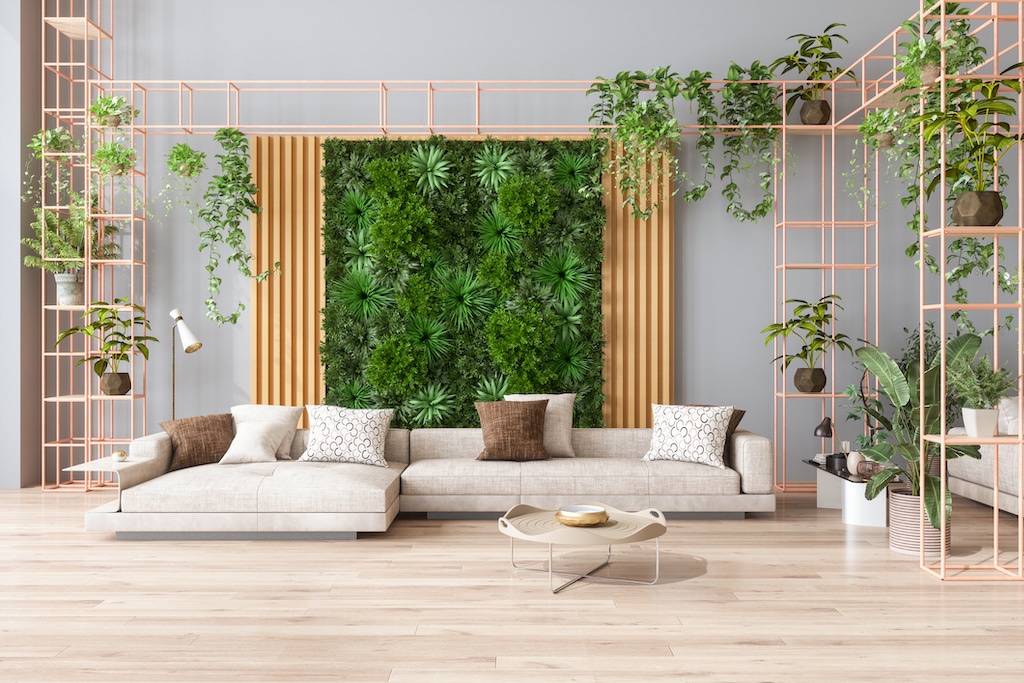
Green Walls: HVAC Efficiency in Fort Worth
HVAC Efficiency in Fort Worth: Are you a homeowner in Fort Worth exploring ways to reduce your energy bills and enhance your home’s comfort?
Have you considered how integrating green walls might boost your HVAC system’s efficiency?
This innovative approach not only beautifies your space but also plays a crucial role in improving the functionality of your heating, ventilation, and air conditioning (HVAC) systems.
In this article, we’ll dive into the importance of HVAC efficiency for Fort Worth residents and introduce the concept of green walls as a sustainable solution to enhance HVAC performance.
Understanding these elements can lead to significant improvements in both energy conservation and indoor air quality, making your home more comfortable and environmentally friendly.
HVAC systems are integral to maintaining a comfortable indoor environment, especially in areas like Fort Worth where temperatures can vary dramatically. Efficient HVAC systems ensure that energy consumption is minimized while still providing the necessary climate control.
Here, we’ll explore how green walls, an innovative and aesthetically pleasing solution, can be part of achieving greater HVAC efficiency. By the end of this section, you’ll have a clearer understanding of how these systems work and the potential benefits of integrating green solutions like green walls into your home.
Importance of HVAC Efficiency for Homeowners in Fort Worth
Why should you, as a homeowner in Fort Worth, care deeply about HVAC efficiency? The answer lies in the substantial benefits that efficient heating, cooling, and ventilation systems can bring to your home—from reducing energy costs to enhancing indoor comfort.
In Fort Worth, where temperatures can soar in the summer and dip in the winter, having an HVAC system that operates efficiently is crucial for maintaining a comfortable living environment without breaking the bank.
An efficient HVAC system helps manage your energy expenses and contributes to a smaller carbon footprint. By consuming less power, you’re not just saving money—you’re also doing your part in reducing the overall energy demand, which in turn supports environmental sustainability.
Moreover, green walls present a unique and innovative opportunity to enhance this efficiency. These living walls of plants not only add natural beauty to your home but also improve air quality and insulation.
This natural layer of plants acts as an additional insulation barrier, keeping your home cooler in the summer and warmer in the winter, easing the workload on your HVAC system.
In the upcoming sections, we’ll delve deeper into how green walls specifically boost HVAC performance and explore some practical tips for integrating these systems into your Fort Worth home.
Homeowners like you can enjoy a more sustainable, comfortable, and cost-effective living environment by understanding and leveraging the synergy between green walls and HVAC efficiency.
Understanding HVAC Efficiency
What exactly is HVAC efficiency, and why is it so crucial for homeowners in Fort Worth?
HVAC efficiency refers to the ability of your heating, ventilation, and air conditioning system to operate at minimum energy use while effectively maintaining an optimal indoor environment. In simpler terms, it’s about getting the maximum comfort for the least amount of energy.
Several key factors influence HVAC performance:
- System Age and Condition: Older systems are generally less efficient than newer ones due to wear and tear as well as advancements in technology.
- Proper Installation and Sizing: Systems that are incorrectly installed or improperly sized cannot run efficiently. Oversized units, for instance, cycle on and off more frequently, which significantly increases energy use and reduces the system’s lifespan.
- Maintenance: Regular maintenance is crucial to keep an HVAC system running efficiently. This includes routine checks and cleanings of filters, ducts, and coils.
- Thermostat Settings: Optimizing your thermostat settings for different times of the day can significantly reduce unnecessary energy use without sacrificing comfort.
- Insulation and Air Seals: Good insulation and sealing improve HVAC efficiency by keeping the desired indoor temperature stable, reducing the workload on the system.
Green walls can significantly contribute to HVAC efficiency. These living structures provide additional insulation and natural cooling through the process of transpiration, where plants release moisture into the air.
This not only helps in maintaining a cooler indoor environment during hot days but also enhances the overall air quality, creating a healthier living space.
The Role of Insulation in HVAC Efficiency
How does insulation directly impact the efficiency of your HVAC system in Fort Worth? Insulation plays a pivotal role in maintaining the desired indoor temperature by reducing the exchange of heat through walls, roofs, and floors.
Effective insulation not only helps keep your home warmer during the chilly winter months but also cooler during the hot Texas summers, thus significantly reducing the burden on your HVAC system.
Here are some key types of insulation and their benefits for HVAC systems:
- Fiberglass Insulation: Commonly found in batts and rolls, fiberglass insulation is effective at trapping air and slowing down the passage of heat. It’s relatively inexpensive and easy to install, making it a popular choice for many homeowners.
- Spray Foam Insulation: This type expands to fill cracks and crevices, providing an excellent air barrier as well as heat resistance. While more expensive, its superior air-sealing properties make it highly effective at improving HVAC efficiency.
- Rigid Foam Board: Often used in exterior wall sheathing, basement walls, and as an underlay for siding, rigid foam offers high insulation value per inch of thickness and can significantly reduce thermal bridging.
- Reflective or Radiant Barrier: This type of insulation is particularly effective in hot climates, like Fort Worth, as it reflects heat away from your home, reducing cooling costs.
Tips for Proper Insulation to Maximize HVAC Efficiency:
- Audit and Upgrade: Consider having an energy audit to identify where your home is losing energy. Upgrading insulation in these areas can have an immediate impact on HVAC efficiency.
- Seal Gaps: Ensure that gaps around windows, doors, and ductwork are sealed. Even small leaks can lead to significant energy losses.
- Consider the Entire Envelope: Insulation isn’t just about walls and attics. Ensure adequate insulation in basements and crawlspaces to provide a complete thermal barrier.
- Regular Inspections: Insulation can degrade or shift over time. Regular inspections can help ensure that your insulation remains effective.
Integrating green walls into this mix can further enhance insulation efforts. Green walls provide a natural buffer against heat, absorbing sunlight and cooling the surrounding air through the process of evapotranspiration.
This additional layer of living insulation can help to moderate indoor temperatures and reduce the workload on HVAC systems, leading to even greater energy efficiency and cost savings.
Green Walls Explained
What exactly are green walls, and why are they becoming a popular feature in urban settings, including Fort Worth?
Green walls, also known as living walls or vertical gardens, consist of panels of plants grown vertically using hydroponics on structures that can be either free-standing or attached to walls.
These innovative structures are not only visually striking but also offer environmental benefits that extend beyond aesthetics.
Benefits of Green Walls in Urban Settings:
- Air Quality Improvement: Green walls act as natural air filters. The plants in the walls absorb pollutants and carbon dioxide, releasing clean oxygen back into the environment. This can be particularly beneficial in urban areas where air quality may be compromised.
- Reduction in Urban Heat Island Effect: By introducing more plant life, green walls can help reduce the urban heat island effect, a common issue where urban regions experience higher temperatures than their rural surroundings. The plants on green walls help cool the air through the process of evapotranspiration.
- Energy Efficiency: As mentioned earlier, green walls provide additional insulation. They help in regulating the temperature inside buildings, reducing the need for heating in winter and cooling in summer.
- Sound Insulation: Living walls can help reduce noise levels. The structure of green walls can block high frequency sounds, and the substrate can help to block lower frequencies.
- Biodiversity: Green walls support biodiversity by providing habitats for various species of insects and birds, thereby contributing to ecological balance.
Green Walls and HVAC Efficiency:
Integrating green walls can directly enhance HVAC efficiency in several ways. The additional layer of plant life helps insulate the building, reducing the amount of heat entering during the summer and retaining more warmth during the winter.
This means that HVAC systems have to work less to maintain a comfortable indoor temperature, leading to reduced energy consumption and lower utility bills.
In Fort Worth, where temperatures can vary significantly across seasons, green walls provide a sustainable solution to improve HVAC efficiency while also enhancing the urban landscape. The next section will delve into specific case studies from Fort Worth that illustrate the practical benefits of green walls in improving HVAC efficiency.
Green Walls and HVAC Efficiency in Fort Worth
How do green walls specifically improve HVAC efficiency in Fort Worth?
By strategically incorporating living walls into urban architecture, homeowners and businesses can significantly enhance their building’s energy performance.
In Fort Worth, where the climate ranges from hot summers to cool winters, green walls provide a dynamic solution to manage indoor temperatures naturally.
Case Studies from Fort Worth:
- Urban Residential Building: A residential building in downtown Fort Worth installed green walls on its southern and western facades. The result was a noticeable decrease in air conditioning use during the hot months, as the green walls blocked direct sunlight and cooled the building’s exterior through evapotranspiration.
- Commercial Office Space: A commercial building incorporated a large green wall in its central atrium. This not only improved the aesthetic appeal and air quality but also regulated the temperature within the large space, reducing the need for artificial heating and cooling.
- Educational Facility: A local school added green walls to its exterior and reported not only enhanced energy efficiency but also an improved learning environment with better air quality and reduced noise levels.
Improving HVAC Efficiency Through Green Walls:
- Strategic Placement: Positioning green walls on sun-facing walls can block and absorb solar radiation during summer, reducing cooling needs.
- Species Selection: Choosing native or drought-resistant plants can minimize maintenance and maximize environmental resilience.
- Integration with Existing Systems: Ensuring that green walls are part of an integrated building design can enhance overall energy efficiency. For example, using green walls in conjunction with solar panels can lead to a more comprehensive approach to sustainable building practices.
The practical implementation of green walls involves consideration of local climate, building orientation, and specific plant species that will thrive in Fort Worth’s environment.
The following section will provide homeowners and building managers in Fort Worth with practical tips for choosing the right plants and structural considerations for installing green walls effectively.

Photo By tomazl at iStock
Practical Tips for Installing Green Walls
Choosing the right plants and understanding structural considerations are crucial for successfully installing green walls in Fort Worth’s climate.
Whether you’re a homeowner looking to enhance your property or a business aiming to improve your commercial space, here are some key tips to ensure your green wall thrives and contributes to HVAC efficiency.
Choosing the Right Plants for Fort Worth’s Climate:
- Heat and Drought Tolerance: Opt for plants that can withstand the hot Texas summers. Species like Sedum, Texas Sage, and Lantana are excellent choices due to their heat resistance and low water requirements.
- Native Species: Using native plants not only supports local biodiversity but also reduces maintenance needs. Native species are adapted to the local climate and soil conditions, making them more sustainable choices.
- Year-Round Greenery: Select plants that maintain their foliage year-round to ensure continuous insulation and aesthetic appeal. Evergreens like Holly Fern or Eastern Redcedar can be good options.
Structural Considerations for Installing Green Walls:
- Weight and Load Bearing: Assess the structural integrity of the wall or facade where the green wall will be installed. Ensure that it can support the weight of the system, especially when fully watered.
- Waterproofing and Drainage: Implement a reliable waterproofing system to protect the building’s structure from moisture damage. Proper drainage is also crucial to prevent water buildup and root rot.
- Irrigation System: Installing an efficient irrigation system is essential for maintaining plant health. Drip irrigation or a built-in watering system can provide consistent moisture and is water-efficient.
- Accessibility for Maintenance: Design the installation so that it is accessible for regular maintenance. This includes pruning, replacing plants, and system repairs.
- Integration with Building Systems: Coordinate with HVAC and building maintenance systems to ensure that the green wall does not obstruct air flows or access points. Integration from the design stage can maximize the benefits and functionality of the green wall.
By following these practical tips, you can enhance the success of your green wall project in Fort Worth.
Not only will this contribute to the aesthetic and environmental value of your property, but it will also improve the efficiency of your HVAC system, leading to energy savings and improved indoor comfort.
Practical Tips for Installing Green Walls
Choosing the right plants and understanding structural considerations are crucial for successfully installing green walls in Fort Worth’s climate.
Whether you’re a homeowner looking to enhance your property or a business aiming to improve your commercial space, here are some key tips to ensure your green wall thrives and contributes to HVAC efficiency.
Choosing the Right Plants for Fort Worth’s Climate:
- Heat and Drought Tolerance: Opt for plants that can withstand the hot Texas summers. Species like Sedum, Texas Sage, and Lantana are excellent choices due to their heat resistance and low water requirements.
- Native Species: Using native plants not only supports local biodiversity but also reduces maintenance needs. Native species are adapted to the local climate and soil conditions, making them more sustainable choices.
- Year-Round Greenery: Select plants that maintain their foliage year-round to ensure continuous insulation and aesthetic appeal. Evergreens like Holly Fern or Eastern Redcedar can be good options.
Structural Considerations for Installing Green Walls:
- Weight and Load Bearing: Assess the structural integrity of the wall or facade where the green wall will be installed. Ensure that it can support the weight of the system, especially when fully watered.
- Waterproofing and Drainage: Implement a reliable waterproofing system to protect the building’s structure from moisture damage. Proper drainage is also crucial to prevent water buildup and root rot.
- Irrigation System: Installing an efficient irrigation system is essential for maintaining plant health. Drip irrigation or a built-in watering system can provide consistent moisture and is water-efficient.
- Accessibility for Maintenance: Design the installation so that it is accessible for regular maintenance. This includes pruning, replacing plants, and system repairs.
- Integration with Building Systems: Coordinate with HVAC and building maintenance systems to ensure that the green wall does not obstruct air flows or access points. Integration from the design stage can maximize the benefits and functionality of the green wall.
By following these practical tips, you can enhance the success of your green wall project in Fort Worth.
Not only will this contribute to the aesthetic and environmental value of your property, but it will also improve the efficiency of your HVAC system, leading to energy savings and improved indoor comfort.
FAQs about HVAC Efficiency and Green Walls
- What is HVAC efficiency?
HVAC efficiency measures how effectively your system maintains comfortable indoor temperatures with minimal energy usage. It’s crucial for reducing energy costs and enhancing comfort in your home. - How do green walls enhance HVAC efficiency?
Green walls provide extra insulation and natural cooling, which reduces the need for mechanical heating and cooling, thereby lowering energy consumption and costs. - What plants are best for green walls in Fort Worth?
Choose heat-tolerant, low-water plants like Sedum, Texas Sage, and Lantana, which are ideal for Fort Worth’s climate and require minimal upkeep. - Are there incentives for installing green walls?
Yes, check with local authorities for incentives or rebates on green installations that boost energy efficiency, as well as potential federal tax benefits. - How often should I maintain my green wall and HVAC?
Inspect and maintain your green wall regularly, and change HVAC filters every 1-3 months. Schedule a professional HVAC check-up at least annually.
Read our previous blog post.
Check out this video: How to Build Green Walls and boost your HVAC efficiency!
Considering adding green walls to boost your HVAC efficiency? What strategies do you use to keep energy costs down in your Fort Worth home? Share your tips and questions below!
Dustin Hufsey


